Head guards are required for damage-prone fire sprinklers, but careful selection is required
Physical damage to a fire sprinkler head is the most common reason for a fire sprinkler to unnecessarily discharge. Whether it’s a rogue basketball in a school gym or a clumsy forklift operator in a warehouse, accidental discharge happens.
No amount of physical protection can stop all unintentional discharges. But adding fire sprinkler head guards to a pendent, upright, or horizontal sidewall sprinkler can provide a critical layer of protection.
In this article, we explain why fire sprinklers need head guards and when fire codes require them. You’ll learn how to choose a fire sprinkler head guard and about the four types we carry: standard, recessed, standard guards with a baffle, and heavy-duty head guards.
Fire sprinkler head guards stop flooding by protecting delicate components
Automatic fire sprinklers feature small, fragile parts that allow water to escape when surrounding temperatures rise. Some have a liquid-filled bulb that bursts at a given temperature. Others have a small metal link, called a fusible link, that falls from the sprinkler head when the metal fusing it to the frame melts.
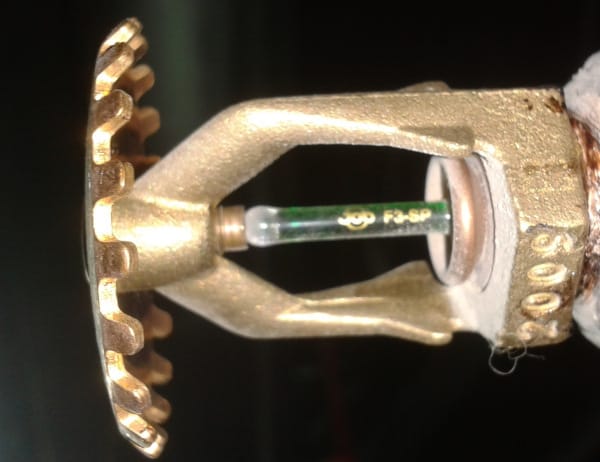
Small impacts can lead to expensive cleanups. Schools, malls, hotels, and other places flooded by unwanted fire sprinkler discharge have paid thousands or even tens of thousands of dollars to repair the damage.
Many of these incidents might have been avoided if the fire sprinklers had guards. A head guard, or sprinkler cage, uses steel wire or another material to put a protective barrier around the sprinkler head.
Most fire sprinkler cages clamp around the base of the sprinkler frame, providing an inch or more of protective metal wiring around the sprinkler. Some fire sprinkler cages are designed for use with one specific type and size of fire sprinkler. Others can protect sprinklers across multiple brands and in multiple sizes.
But because regular head guards secure to the base of fire sprinklers—and can sometimes be installed only by removing the fire sprinkler head—the size of the fire sprinkler’s thread connection matters. Most fire sprinklers have a thread connection in one of two sizes: 1/2″ or 3/4″. That said, one type of head guard — heavy-duty head guards — attaches to the pipe surrounding the sprinkler. We’ll cover those models in more detail below!
Impact-prone heads in NFPA-compliant fire sprinkler systems require listed head guards
In cities around the United States, local governments have adopted fire codes referencing standards by the National Fire Protection Association (NFPA). And NFPA 13: Standard for the Installation of Sprinkler Systems requires cages for select fire sprinklers:
From the 2022 edition of NFPA 13
16.2.6 Sprinklers subject to mechanical injury shall be protected with listed guards.
Fire sprinkler system designers place each sprinkler with several factors in mind, and if the sprinkler’s spray can’t get to where it needs to go, a fire may spread. So, when this standard calls for a “listed” guard, it means that fire sprinkler cages are evaluated for use with specific sprinkler models, ensuring that their discharge pattern and coverage remain unaffected.
Non-listed fire sprinkler cages are typically designed for a special purpose. Some protect against “occasional light contact,” but not against direct impacts. Others act as temporary head guards, protecting sprinklers during renovations or in other situations where sprinkler heads may face intense impacts.
Before purchasing or installing a new head guard, check with your local fire marshall or authority having jurisdiction (AHJ). Here’s a review of the main types of head guards:
Standard fire sprinkler head guards are the go-to solution for many fire sprinkler types
A standard sprinkler cage protects non-recessed pendent, upright, or horizontal sidewall fire sprinklers. In simpler terms, this type of head guard is suitable if the base of the sprinkler’s frame is flush with the disc, or escutcheon, surrounding it.
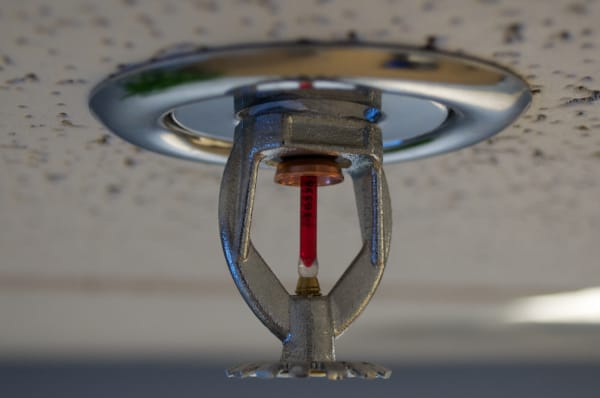
QRFS stocks this type of fire sprinkler head guard in three colors: fire-engine red, chrome, and white. These head guards, designed for occasional light contact, can be attached during installation or during a retrofit.
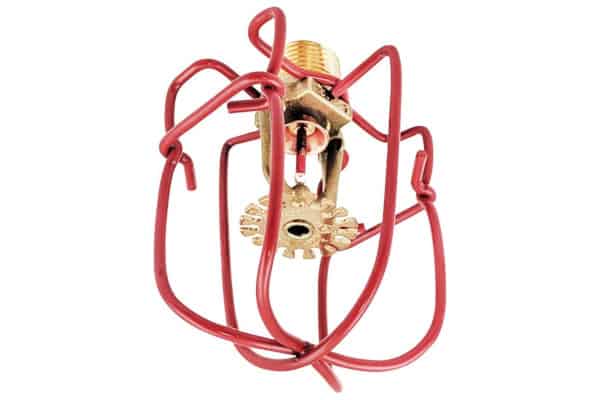
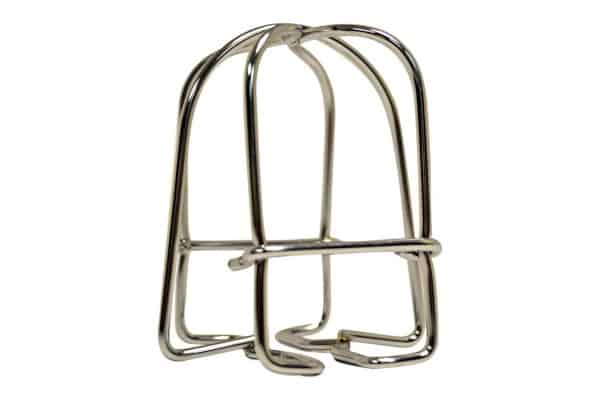

Recessed fire sprinkler head guards protect recessed pendent sprinklers
These head guards have an extended base that allows them to grip the thread connection on a recessed fire sprinkler. Recessed sprinklers, like the one pictured below, sit in an escutcheon with a slight indentation. The base of the frame isn’t quite flush with the ceiling.

This head guard provides protection for the part of the sprinkler exposed below the ceiling and extra cushion around the recessed bottom half of the frame. QRFS’s recessed head guard is available in a chrome finish. Like our other guards, these protect against light contact and fit both 1/2″ and 3/4″ fire sprinklers.
A standard head guard with a baffle meets the needs of sprinklers in storage applications
In shelving and storage applications, spray from one fire sprinkler can cause another to discharge too late. The standard head guard with a baffle protects upright fire sprinklers and stops water from nearby sprinklers from cooling the sprinkler’s heat-sensitive element. QRFS carries sprinkler cages with baffles to protect sprinklers against light contact, including the red guard pictured below. Like our other guards, this head guard fits both 1/2″ and 3/4″ fire sprinklers.

You can also purchase water shields and baffles separately that are compatible with specific sprinklers.
An emerging selection of heavy-duty head guards promises extra protection for sprinklers in high-impact environments
The head guards shown so far do an excellent job of protecting against small collisions — and prove equally useful in warning passers-by to keep their distance. But they’re not strong enough to protect against especially severe forms of damage. In environments where heavy objects pass near sprinkler heads, where fast-moving objects fly through the air, or where a broken sprinkler head could prove extremely costly, installers now have the option of using heavy-duty head guards.
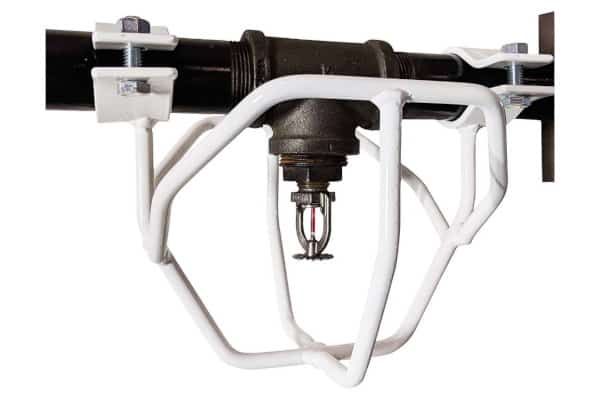
These extra-large guards secure directly to sprinkler pipes, and are available in three configurations:
- Horizontal pipe runs
- Vertical pipe ends
- Horizontal pipe ends
Here’s a list of common sprinkler and heavy-duty head guard pairings:
- Pendent or upright heads directly on a branch line tee — horizontal pipe runs
- Pendent sprinklers on a drop — vertical pipe ends
- Upright sprinklers on a sprig — vertical pipe ends
- Sprinklers on an elbow where pipe terminates — horizontal pipe ends
For more on heavy-duty head guards, click here to browse our selection, or check out these articles:
- Heavy-Duty Fire Sprinkler Head Guards Protect Sprinklers from Hard Hits
- Fire Sprinkler Accident Videos: The Hall of Shame
Head guards provide cost-effective protection against costly accidents
Breaking a sprinkler head is no small matter. For contractors and facilities managers looking to avoid a major headache — one that involves calls to the fire department, insurers, water damage repair contractors, and fire sprinkler installers — head guards are an investment that can’t be beat.
Click here to view QRFS’s full selection of fire sprinkler head guards.
Questions about protecting your sprinklers? Call us at +1 (888) 361-6662 or email support@qrfs.com.
If this article helped you choose a head guard, check us out at Facebook.com/QuickResponseFireSupply or on Twitter @QuickResponseFS.


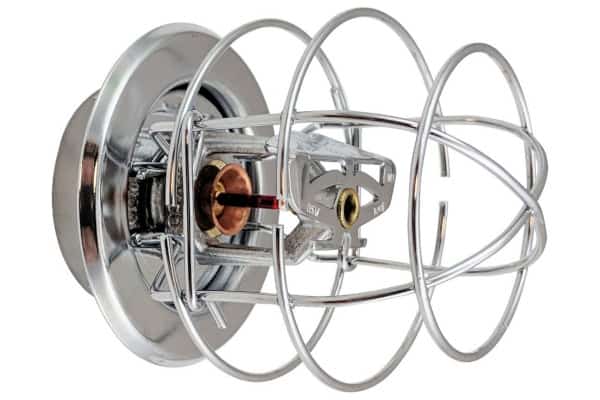
Needing heavy duty sprinkler guards.
Scott — thank you for reaching out. We will have someone from our QRFS Customer Support Team contact you.
question: can head guards be painted aftermarket? I can’t find a section on the code that says otherwise.
Jar – There are no specific references to painted head guards in NFPA 13 or 25, though there are those for painting fire sprinklers — the latter is forbidden. Head guards must be listed, however, and there theoretically could be an implied prohibition if paint interferes with the performance characteristics of the head guard and sprinkler it was designed for. If you’d like, you can try our Ask a Fire Pro service for a more definitive answer and accompanying research. Click the link to submit your question with some information about your building and system, and a fire protection professional will provide an answer based on best practices, standards, and codes. Our pros include AHJs, contractors, engineers, and code experts with 150+ years of combined experience!
I will be working around sprinkler heads in several mechanical rooms in an apartment building. Do you have a typical or universal cover I can use while working near them and then take them off after we are done?
James — Fire sprinkler paint covers may fit the bill, though they won’t ensure protection against hard hits. They are highly visible and may provide *some* protection, however.
Are your guards listed?
Do you have something that will work with recessed heads that are white?
Rod — The head guards within QRFS’s inventory from Viking are listed; the others are not, and should should only be used if the appropriate authority having jurisdiction approves their use. The only recessed guards we currently carry are chrome or red, though QRFS is expanding its inventory with a variety of listed guards from various manufacturers next year, if your needs are not time-sensitive.
We have had a sprinkler head get hit by a basketball, it broke the head and flooded our gym. it had a cover on it, so we were surprised that it was not protected. That being said, I need to know if there are different cages that would give more protection.
Shelly – “Heavy-duty” head guards exist that can protect against harder hits, such as a basketball. However, they are not “listed” for use and thus must be approved by your applicable authority having jurisdiction first (AHJ; fire inspector) before they can be employed.
Looking for a recessed pendent head guard that will protect from a golf ball strike.
Anthony – We’re not certain of the exact velocity of a golf ball strike, but a standard head guard that’s listed to go with the specific sprinkler may or may not offer sufficient impact protection (and cage surface area to block the ball). Certainly worth a try. Also, different head guards attach in different ways, so those that have the screws on each side that screw tight might offer more stability than those that clip together.
Heavy duty head guards are stronger and offer more impact protection, but they are large enough that a golf ball may get into the cage (and they are not listed and thus require approval from the authority having jurisdiction).
Another way to go is to install concealed heads with cover plates, if it’s feasible.